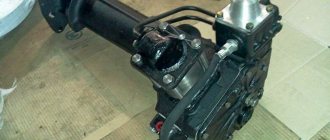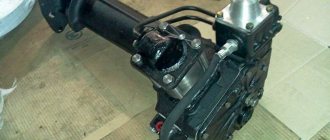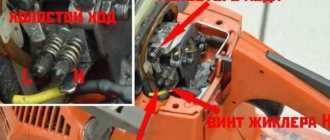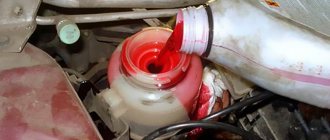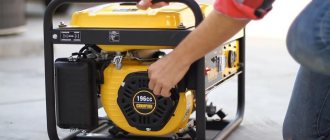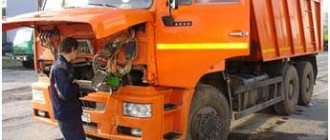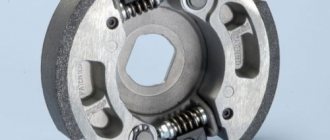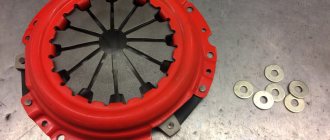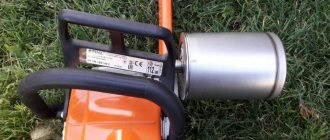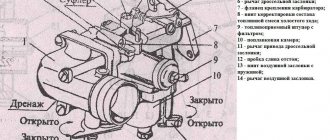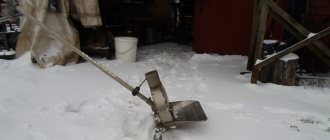How does power steering work?
The power steering housing is made of cast iron and is placed on a beam of the car frame.
On the sides of the unit there is a control radiator and the hood wall. Power steering is a powerful mechanism equipped with a worm gear. Additionally, the unit design is equipped with:
- hydraulic system;
- a spool, due to the operation of which it is possible to achieve the required pressure and facilitate turning;
- gear hydraulic pump;
- cylinder;
- safety valve.
The structure is driven by the rotation of the gear, and the hydraulic pump begins to move first, followed by the remaining elements.
Principle of operation
There is a worm in the power steering housing, which is additionally tied with turns. A spool is installed on the end part. The ends of the part are provided with bearings to support the structure. During operation of the unit, plungers rest against the bearings, creating pressure. In turn, on the other side, the springs rest against the housing, the parts of which are also part of the design of the amplifier.
Due to the work of the springs, it is possible to fix the position of the spool, preventing it from moving in different directions. When the tractor driver begins to rotate the wheels, making a maneuver, the sector of the assembly moves under the influence of a worm, which rotates in turns. As a result, the bipod shaft rotates.
During rotation, resistance arises in the wheels, which is absorbed by the worm. This rotation creates a certain force, under the influence of which the worm moves forward or backward along one axis, depending on what maneuver the driver performs.
During the movement of the worm, the spool of the force distributor of the unit is activated simultaneously with it, which also begins to move along the axis. The movement of the spool affects the oil flow, distributing its supply into the cavities.
If the car is moving straight, the spool is in the neutral position, supported by the springs. Pressure enters the power steering housing, which is also the hydraulic tank of the unit system.
When the steering wheel rotates, the force applied to the hydraulic booster causes the worm to move, which, in turn, changes the position of the spool. With the help of the belts provided on the spool, the lines of the cavities inside the cylinder are opened. Depending on which direction the turn was made, one receives oil, and the second becomes a drain for liquid.
Pressure inside the cavity with oil is supplied by the spool only when the steering wheel begins to rotate. As soon as the wheel stops, the worm stops moving, and along with it the spool brakes, which with the help of springs returns to its original position. The oil is discharged into the cavity, which is responsible for draining.
Additional items
The design of the unit includes a piston, which acts on the rack during movement. The piston is connected to one of the sectors of the hydraulic booster and is responsible for pumping pressure inside the cylinder. When pressure is supplied to one of the cavities due to the operation of the spool, force is simultaneously transferred to the rack, which begins to move the sector.
The standard pressure in the hydraulic system is 2-4 MPa. If the tractor owner decides to turn the steering wheel to the maximum, the pressure can rise to 8 MPa.
Design and principle of operation
The cast iron housing of the MTZ 80 (82) power steering is located on the front frame beam between the front front wall of the hood and the diesel engine cooling radiator of the machine. The unit is a mechanism with a worm gearbox, equipped with an autonomous hydraulic system with a spool for controlling the flow of working fluid, a left-hand rotation gear hydraulic pump NSh-10-L-U GOST 8753-71, a double-acting power cylinder and a safety valve. The system's hydraulic pump is driven by the engine timing gear.
A worm is installed in the amplifier body, connected by turns to the sector and its end part to the valve spool of the assembly. At the ends of the spool there are thrust bearings, into which the plungers rest under the pressure of the springs. At the same time, the outer sides of the plungers rest against the housing parts of the distributor. Plungers and springs hold the spool in the neutral position through bearings. When the steering wheel rotates, the worm begins to move the sector in turns, turning the bipod shaft. The resulting resistance of the wheels is transmitted through the mechanism to the worm, forming a force that moves it axially forward or backward depending on the direction of rotation. By its displacement, the worm interacts with the valve spool of the assembly, moving it relative to the axis. Thus, the spool controls the flow of oil under pressure. When moving straight, the distributor spool, spring-loaded, is in the neutral position, the pressure supplied by the pump is released into the amplifier housing, which is the hydraulic tank of the system.
By rotating the steering wheel, the worm moves the spool, which opens the lines of the cavities of the power cylinder with its belts. Moreover, depending on the direction of rotation, one cavity is connected to a line supplying oil under pressure, the other to a drain. The spool drops pressure into the cylinder cavity only during direct rotation of the steering wheel. When the steering wheel stops, the worm stops acting on the distributor spool, which, under the force of the springs, takes a neutral position, dumping oil into the drain cavity.
The piston of the cylinder 25 interacts through the rod with the rack 14, connected to the sector 12. When the spool supplies pressure to one of the cavities, the rod transfers force to the rack, moving the sector, facilitating the rotation of the shaft 28 associated with the bipod 13. The working pressure in the hydraulic system is 2-4 MPa. By turning the steering wheel to the maximum angle of rotation, the pressure reaches its maximum value of 8 mPa and is limited by safety valve 7.
The driver’s feeling of “Road Feeling” of resistance to turning during steering is provided by the pressure from the discharge channel in the cavities with springs acting on the plunger. When controlled without force, the worm does not interact with the spool and the hydraulic system does not participate in the amplification.
Important The best asphalt spreaders: 5 most popular models
Additionally, the unit is equipped with a differential automatic locking sensor located in the rack stop. The device includes a spool 21, a rotary valve 18 with a flywheel, a pusher and a feeler gauge 20. An unregulated pressure reducing valve maintains a pressure of 0.7-0.9 MPa in the locking hydraulic system. The device provides differential locking when driving straight and automatically turns it off when the wheels are turned more than 8 ̊.
Setting up power steering - adjusting the unit
Adjustments can be made in the following areas:
- The “worm” - sector “engagement is carried out by turning the sleeve clockwise until it stops (with the bipod in the middle position), followed by turning it in the opposite direction (about 10-12 mm) and tightening the fixing bolt;
- Engagement “sector - rack” - adjustment is achieved by reducing the adjusting shims until a gap from the rack to the stop is formed of 0.1-0.3 mm;
- The tightening of the nut on the worm is adjusted after first securing the distributor with the fixing bolts. The nut itself is tightened with a torque of 2 kgf/m and then unscrewed by approximately 1/12 - 1/10 of a turn, until the holes on the cotter pin and worm converge, after which it is cottered;
Axial type stroke on the rotary shaft - is set using a slightly loosened locknut and screwing the adjusting bolt into the end of the shaft until it stops, then turning it back 1/8 - 1/10 of a turn and fixing it with a locknut;- Safety valve - adjusted using a pressure gauge connected to the valve cover or a discharge line, turning the adjusting bolt on the valve itself until a pressure of 88 kgf/cm2 is obtained;
- The blocking valve on the differential is controlled in the following order: the valve is switched to the “off” state and locked; the cable is secured, after which it is pulled out using a coupling and secured with special screws; the tap is removed from its fixation; the handle is moved to position II, and the tap itself returns to the “on” position.
Power steering hums when cold
Troubleshooting power steering and steering rack
There are several reasons why the power steering hums when cold. The first is that air is leaking through the low pressure lines. To eliminate it, it is enough to put two clamps on the tube going from the reservoir to the power steering pump. In addition, it is worth replacing the ring located on the suction pipe of the pump itself. After installing the clamps, we recommend that you use an oil-resistant sealant to coat the clamps and joints.
You can also conditionally identify another reason, the probability of which is low. Sometimes there are cases when the power steering system is insufficiently (poorly) pumped. In this case, an air bubble remains at the bottom of the tank, which is removed using a syringe. Naturally. that its presence can cause the indicated hum.
Elimination methods may include replacing oil hoses and/or racks, replacing the power steering pump, installing additional clamps on all hoses in order to prevent air leaks into the system. You can also perform the following procedures:
- replacing the O-ring on the expansion tank supply spout;
- installing a new hose from the reservoir to the pump using oil-resistant sealant;
- perform the procedure for expelling air from the system (when performing the procedure, bubbles will appear on the surface of the liquid, which must be given time to burst) by turning the steering wheel with the engine not running;
Important: TOP 6 manufacturers of reliable cordless grass trimmers: the best models in terms of price and quality
Another repair option is to replace the O-ring in the power steering pressure suction hose (and, if necessary, the hose itself and both clamps). The fact is that over time it loses elasticity and becomes rigid, that is, it loses elasticity and tightness, and begins to let air through, which enters the system, causing knocking and foam in the tank. The way out is to replace this ring. Sometimes a problem can arise because it can be difficult to find a similar ring in a store. But if you find it, be sure to replace it and place it on the mount and lubricate it with oil-resistant sealant.
For some cars, a special power steering repair kit is available for sale. If problems arise with this unit, the first thing you need to do is buy a repair kit and change the rubber gaskets that are included in it. Moreover, it is advisable to buy original kits (especially important for expensive foreign cars).
Power steering pump bearing
It is also necessary to ensure that there is no dirt in the system fluid. If it is present even in small quantities, over time this will lead to wear on the parts of the power steering pump, which will cause it to begin to make unpleasant sounds and work worse, which will be expressed in increased effort when turning the steering wheel, as well as possible knocking. Therefore, when replacing the fluid, be sure to check for dirt deposits at the bottom of the expansion tank. If they exist, you need to get rid of them. Check the filter in the tank (if there is one). It should be relatively clean and intact, tightly adjacent to the walls of the tank. In some cases, it is better to replace the entire tank and filter rather than try to clean them. Also in this case, it is necessary to remove the rail, disassemble it, wash it from dirt, and also replace the rubber-plastic parts. To do this you need to use the mentioned repair kit.
An unpleasant sound may come from the outer bearing of the power steering pump. Its replacement is easy, without the need to completely disassemble the unit. However, sometimes it can be difficult to find a replacement for him.
There are special additives that are added to power steering fluid. They eliminate the hum of the pump, relieve effort on the steering wheel, increase the clarity of the power steering, reduce the level of vibration of the hydraulic pump, and protect system parts from wear when the oil level is low. However, motorists have different attitudes towards such additives. They really help some, but they only harm others and speed up the time for replacing the power steering pump or replacing it.
Therefore, we recommend that you use additives at your own risk. They only eliminate the symptoms of the malfunction and delay repair work on the pump or other elements of the power steering system.
When choosing a liquid, pay attention to its temperature characteristics so that it works normally in severe frosts (if necessary). Since oil with high viscosity will create obstacles to the normal operation of the power steering system
Wheels do not turn on MTZ 82 power steering adjustment
Questions can only be asked after registration.
Please login or register. Tell me about the hydraulics of the steering wheel, what is there and how to adjust it on the MTZ 82. The problem is turning the steering wheel, it doesn’t turn to the right at all, but only half to the left. free play 1.5 turns at the steering wheel. and when I turn left, the wheels turn a little later than the steering wheel.
I've already done it all. The nut is in place, the splines are not loose, the worm sector engagement is loose, but not critical. I can’t quite figure out how this system works and why the steering wheel won’t turn.
I had this happen, I didn’t turn it in one direction, the thrust bearing was broken, in the power steering distributor, in front you need to remove the cover with 4 bolts
The bearings are all intact, the engagement is normal with both the worm and the cylinder. there are no backlashes. What is the lock sensor and what function does it perform? could that be the problem?
If everything is fine, then check how the steering knuckles, that is, the final drives. If 82, they turn.
Now I took everything apart, cleaned it, put it back together, the situation has changed, it turns out that it spins almost two turns in one direction, and about 0.8 turns in the other. and the problem with the lag remains. You turn the steering wheel, the wheels a little later. I haven’t tried it on the go though. How many turns of the steering wheel should there be in each direction?
It started for me when the wheels started to chatter, and following the advice I set the toe-in to zero, although I think that’s where it started, because everything was normal. Then it got worse, I set the wheels to minus, the free play of the steering wheel became more, then I drove off pull out the lawn, pull it out, go home, but it doesn’t turn to the right, to the left as it should, but it’s just late in turning, the sensations are incomprehensible. By the way, they were in the center (the wheels), and to the right about half a turn (maybe 0, 8 as the author of the topic writes) And then it was as if the steering wheel was resting against some kind of limiter, I thought I would tear the steering wheel off. While driving home, I thought about where the hydraulic cylinder piston should go when turning left and right, I decided to start with it. It turned out, as I thought, the thread on stock, the steering wheel still worked with a delay, but there was some looseness while I was holding the cotter pin on the nut, naturally there was play there. Now I’ll go get a new one.
I changed my cylinder right away, now I have a new one, I still have to catch the steering wheel on the road and turn in one direction a little. the fingers are in the rods, the bipod and the distributor are also new.
Well, are the lengths of the rods the same? Is the rack positioned correctly? Maybe the teeth are not correct? Damn, there are no rods for sale separately... I don’t want to pay 1600 for a new one
yes, the rack is on the marks, the traction is the same. Well, there is some play in the rack, is it somehow adjustable?
Yes, it can be adjusted by throwing out the shims from under the locking sensor. By the way, is your eccentric mounted on a worm? That is, it’s where the steering shaft is screwed to the steering column shaft, damn, it’s easier to take a photo.. now. If it’s all the way to the right, then it will be difficult to turn, and it seems like it almost doesn’t turn in one direction at all. You need to look. Is there free play in the steering wheel? This eccentric can be used to clamp the spool and that’s it.
Yes, no matter how much I turn this eccentric, there is no change at all. What kind of blocking sensor is this? I don’t understand what role it plays?
There are adjusting shims underneath, the rack-sector gap is adjusted, if on the cab side, then on the left side
Oh damn... How did you install the distributor, tightened the nut on it probably with a wrench, the one with the cotter pin? Is the steering wheel tight and light?
no, the distributor was tightened by hand with a slight play. The steering wheel is relatively easy to turn, only with a delay and low revs. Well, I understand that there are adjusting shims under the sensor, today I’ll try to remove the gap. but why is it needed at all? If it's a blocking sensor, does that mean it must block something? what and where? and how it works. I also twisted it in different directions. no changes.
The locking sensor controls the differential locking of the rear axle. The lock is activated from the cab and has 3 positions (automatic, forced). In the “automatic” position, the sensor monitors the position of the front wheels, turns off the lock when the steering wheel is turned, and turns it on when the tractor moves in a straight line.
how should this sensor be connected? My lock doesn't work.
Look at this topic https://fermer.ru/forum/selskokhozyaistvennaya-tekhnika/136660 there are pictures and a description of the locking device.
Yes, my hands will never reach the tractor yet. It's blowing my mind. I bought a new one for the tractor, I’ll try to change it the other day, maybe it will help.
Well, then all that remains is to remove this entire system and install the mountain.
Well, then all that remains is to remove this entire system and install the mountain.
If you don’t delve into the principle of operation, then the mount won’t help. Are the markings all normal? The sector-rail markings are visible through the steering filler neck
fine. Everything is already normal there, but it doesn’t work. As soon as it gets warmer I will rearrange it.
Last week in the forest, my tractor refused to turn first to the left, and then after half an hour it turned to the right - the steering wheel is stuck and while driving I can barely turn the wheels, well at least the brakes work - with their help I managed to get home with grief. The reason turned out to be in a jammed glass in the side bushing. When disassembling with the help of WD hammers, mounts and some kind of mother, we somehow managed to remove the side one from the kingpin (I installed a new kingpin in the fall, there is no stem in the sleeve) in short, metal has grown on the kingpin from the sleeve - it’s not clear how - in a stripe of about from 5 to 10mm. Lubrication is present - the lower part of the sleeve is all in nigrol, the upper part did not even have time to dry and the rubber bands are normal. In short, I peeled off these growths, lubricated everything with the same and reassembled it - the steering worked as before. I almost bought a new one because of stupidity - well, the store didn’t have it in stock. I came home and checked the hydraulic part with a device - everything was normal, but the problem turned out to be mechanical. This is the first time in my life I’ve come across such crap in more than two decades of working on and with equipment.
Source
The design and principle of operation of the MTZ-80 power steering. Adjustments and repairs.
For comfortable and efficient driving, the steering mechanism of the MTZ 80(82) tractor is equipped with power steering. The unit performs the function of transmitting rotation from the steering wheel to the steering bipod while simultaneously easing the effort when turning and mitigating reverse vibration when driving on roads with uneven surfaces. Strengthening is achieved by fluid pressure acting on the working parts of the mechanism.
The unit was installed on earlier MTZ-80(82) models and is not inferior in its functional and performance qualities to the later installed hydrostatic power steering system - GORU.
How to pump power steering
How to fill oil and bleed power steering
The procedure for replacing fluid and pumping power steering is carried out in strict accordance with the existing algorithm. Some automakers may add their own features to it. If you have a manual for your car, we recommend that you read the relevant section. In general terms, the steps must be performed in the following sequence:
- Raise the vehicle completely on a lift or with the front wheels off the ground.
- If necessary, drain the old fluid from the expansion tank. To do this, remove the return hose (going to the power steering system) from the expansion tank and put a plug on it so that liquid does not spill out of the hose. A hose leading to an empty bottle is connected to the released tap on the tank, where the old hydraulic fluid is supposed to be drained.
- It is most convenient to pump out the main volume of liquid with a syringe and pour it into a separate bottle. When there is very little liquid left, move on to the next point.
- Fill the expansion tank with working fluid to the top.
- Next, you should turn the steering wheel from side to side (from lock to lock) several times so that the old fluid remaining in the system flows out through the hose. Since the new fluid displaces the old, do not forget to monitor the oil level in the tank so that air does not get into the hose.
- If the fluid level drops, add it again.
- Start the engine for 2-3 seconds and turn it off. This is done so that the liquid begins to spread throughout the system.
Important TOP 5 modifications of the MAZ-6303 truck from the Minsk Automobile Plant
It is important to remember that if you have aired the power steering system, the air can be expelled by bleeding it by rotating the steering wheel from side to side. However, do not start the engine under any circumstances, since the air in the system is critical for the power steering pump and can cause its failure.. Pumping out the oil with a syringe
Pumping out oil with a syringe
- Next, add working fluid to the tank to the MAX level and repeat the procedure by starting the engine. Repeat this cycle 3-5 times.
- The signal to stop pumping is the fact that air from the return hose stops entering the drain bottle. This means that there is no more air left in the hydraulic system and fresh, clean fluid enters the reservoir.
- After this, you need to reinstall the return hose (connect it to the expansion tank where it was originally installed).
- Refill the reservoir to the MAX level, then start the engine.
- To pump the hydraulic booster, you need to slowly turn the steering wheel 4-5 times from the left to the right stop. At the stop points, pause for 2-3 seconds. If there is any air left, it should escape into the expansion tank. During the inspection process, we make sure that the pump does not make any extraneous noise.
- An indicator that pumping has ended will be the absence of air bubbles on the surface of the liquid in the tank.
- After this, close the expansion tank tightly.
Bleeding the power steering system
The system can also be pumped without starting the engine, “cold”. To do this, just rotate the steering wheel from left to right stops. At the same time, old fluid and air leave the system. However, most automakers still recommend bleeding the system with the engine running.
The fluid level in the reservoir should be between the MIN and MAX marks. Remember that when heated, the liquid expands, so you should not pour it beyond the existing mark.
Do-it-yourself repair of power steering tractor T-40
The price for a T-40 power steering ranges from 10-13 thousand rubles; a comprehensive repair will cost about the same amount. Therefore, making repairs yourself and performing maintenance yourself is the best option for the tractor owner. Thanks to the video, you can learn in more detail about the repair of the T-40 steering column.
Disassembly and assembly
Disassembling the T-40 power steering is performed according to the following instructions:
- when disassembling the piston assembly, press the pin located in the rear nut all the way;
- the nut must be unscrewed and removed together with the spring washer;
- The screw is pushed towards the front cover, then the spool with springs and stops is removed.
Assembly is performed in reverse order, but the following tips should be followed:
- make sure that when assembling the pin is on the side of the back cover;
- the spool must move freely, without friction or jamming;
- before assembling the power steering, the component parts are washed with clean diesel fuel;
- The spool also needs to be washed and treated with diesel oil.
How to properly install the power steering of the T-40 tractor
When installing and assembling the T-40 power steering, special attention should be paid to the position of the screw, since it is equipped with a multi-start thread. You will need to select the correct position for its entry, leaving a gap of 1 mm between the piston and the nut (preferably without deviations)
To ensure proper installation, it is recommended to follow the following instructions:
- together with the cover and the front nut, the screw is inserted into the piston so that in the operating position the thickening of the tooth faces the bottom and the pin is in front;
- The position of the pin is fixed and the rear nut is screwed. The nuts are fastened with a slight tension so that the depth from the end hole of the rod does not exceed 17 cm. If you tighten it more, the pin may not fit into the right place. A click will indicate that the pin has entered correctly.
Possible faults
The products of the Minsk Tractor Plant are of high quality, excellent technical characteristics and long service life, but over time they may require repairs and adjustments. Owners of MTZ tractors have to deal with several typical power steering breakdowns, which include:
To eliminate such faults, it is strongly recommended to disassemble the unit and troubleshoot individual elements, and then replace the damaged parts with new ones. After carrying out the work, you will need to install the unit in place, and then adjust it.
Setup and repair
If it is necessary to improve the power steering MTZ 80 or eliminate minor damage, it is enough to perform a detailed adjustment of this mechanism. To do this, it is advisable to adhere to the following instructions:
In addition to adjusting the unit, maintenance may need to be performed to help keep the power steering in optimal condition. Most often, it is necessary to wash the oil filter, which can be done by lifting the lining, dismantling the oil line and cover.
Some breakdowns, such as difficulty turning, may indicate insufficient fluid volume in the hydraulic system, improper adjustment, or worn cylinder o-rings.
Measures to repair hydraulic steering mechanisms of a tractor seem to be quite complex and require special equipment to monitor performance indicators. In some cases, it may be easier to install the MTZ 80 power steering assembly, which will avoid problems with finding broken elements. To do this you will need:
Purchasing an assembled hydraulic booster seems to be a much more expensive solution than sequential adjustment and troubleshooting of its parts, but it allows you to quickly solve problems that have arisen.
